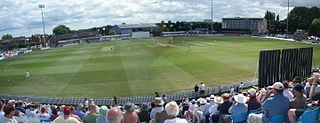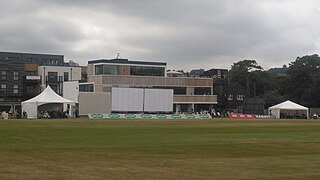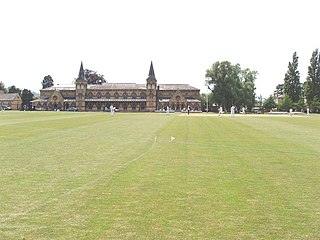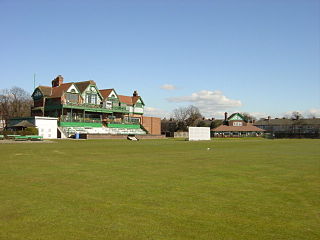
The Pattonair County Cricket Ground is a cricket ground in Derby, England. It has been the home of Derbyshire County Cricket Club since 1871. The ground was first used by South Derbyshire Cricket Club in 1863 and was initially located within Derby Racecourse, although racing ceased after 1939. The ground has staged two One-Day Internationals: New Zealand against Sri Lanka during the 1983 World Cup and New Zealand against Pakistan during the 1999 World Cup. It was one of the venues for the 2017 Women's Cricket World Cup.

The County Ground is a cricket venue on Wantage Road in the Abington area of Northampton, England. It is home to Northamptonshire County Cricket Club.

Hull Paragon Interchange is an integrated rail, bus and coach station in the city centre of Kingston upon Hull, England. The G.T. Andrews-designed station was originally named Paragon Station, and together with the adjoining Station Hotel, it opened in 1847 as the new Hull terminus for the growing traffic of the York and North Midland (Y&NMR) leased to the Hull and Selby Railway (H&S). As well as trains to the west, the station was the terminus of the Y&NMR and H&S railway's Hull to Scarborough Line. From the 1860s the station also became the terminus of the Hull and Holderness and Hull and Hornsea railways.

The Sports Ground, Woodbridge Road is a cricket ground in Guildford, Surrey. The ground was given to the town in trust in 1911 by Sir Harry Waechter, Bart. Guildford Cricket Club play their home matches on the ground. Surrey CCC play one County Championship match and one List A one-day match there each season, as well as some second XI fixtures. Until comparatively recently, hockey was played on the ground in winter. The ground was also used for football until at least 1921. It was the home ground of the amateur team Guildford F.C. who existed until 1953 and was also used as the venue for some Surrey Senior Cup finals.

The College Ground is a cricket ground in the grounds of Cheltenham College, England. Gloucestershire County Cricket Club have played more than 300 first-class and more than 70 List A matches there. It also hosted a Women's One Day International between England and Australia in 2005.
The Parsee tour of England in 1886 was the first cricket tour of England by a team from India. While the tour was singularly unsuccessful in terms of results, it paved the way for another trip by the Parsees two years later and more tours by English teams to India in the next decade.
Anlaby Road was a sports venue in Hull. The ground was used for football club Hull City between 1906 and 1939. The record attendance was 32,000 in a FA Cup game against Newcastle United. The stands were bombed during World War II but Hull City used the site for training and reserve matches until 1965, when a railway line was built over the pitch.
Leonard Jackson was an English cricketer who played for Derbyshire from 1877 to 1882.
Prince's Cricket Ground in Chelsea, London was a cricket ground, created by the brothers George and James Prince as part of the Prince's Club, on which 37 first-class matches were played between 1872 and 1878. The ground was built on in 1883. The boundaries of the site, laid out on the former Cattleugh's nursery gardens, are marked by Cadogan Square West, Milner Street, Lennox Gardens Mews, Walton Street and Pont Street.
Birch Lane was a rugby league ground in Bradford, England. It was the first long term home of Bradford Northern Rugby League Football Club, who played there for 26 years from 1908 to 1934 before moving to Odsal Stadium. For a short while it was also home to Bradford F.C. in their first incarnation as a football club. Birch Lane was described as "notorious" and a "poverty-stricken place" and was never popular either with Northern or Bradford F.C. for the short period they were there.

Park Avenue is a sports ground on Horton Park Avenue in Bradford, West Yorkshire, England. It was used for both cricket and football. It held 306 first class and 48 list A cricket matches between 1881 and 1996, and was home to former Football League club Bradford, to which it lent its name.

Aigburth Cricket Ground in Liverpool, England, is the home of Liverpool Cricket Club. The club was founded in 1807 and is the oldest amateur sports club in Merseyside. The ground hosted its maiden first-class cricket match in 1881, a fixture between Lancashire and Cambridge University.
The Royal New Ground, also known as "Box's Ground", in Brighton, Sussex was a venue for first-class cricket matches from 1814 to 1847. Originally called "Brown's Ground" in the 18th century, it was located where Park Crescent, Brighton now stands.
The United South of England Eleven (USEE) was an itinerant cricket team founded in November 1864 by Edgar Willsher, as secretary, and John Lillywhite, as treasurer. The USEE had no home venue as its prime purpose, like all similarly named teams of the time, was to operate as a travelling show and bring top-class cricket to places in Great Britain and Ireland which rarely received it. Fourteen USEE matches have been recognised by CricketArchive as first-class, mostly against the rival United North of England Eleven (UNEE). The USEE is estimated to have played 217 "odds" matches as a visiting team against local club sides which generally used 22 players.

Tyler's Ground was a cricket ground in Loughborough, Leicestershire. It is believed the ground was located along Allsop's Lane on the edge of the town, with the ground being described as located a short distance from Loughborough railway station. The first recorded match played at the ground was in 1856, when Loughborough played an All-England Eleven. A single first-class match was played at the ground in 1875, when the North played the South, with W. G. Grace taking nine wickets in the North's first-innings and William Mycroft taking six wickets in the South's first-innings. Grace then took five wickets in the North's second-innings, ending with match figures of 14/108, while Mycroft took eight wickets in the South's second-innings to finish with match figures of 14/38. No batsman passed 26 runs, with the highest innings score being 130 in the North's second-innings. The match ended in a victory by 125 runs for the North. No further matches are recorded as being played at the ground following this date and its location is today agricultural fields.
Merefield Ground was a cricket ground in Rochdale, Lancashire. Located alongside Merefield Road, the first recorded match played at the ground came in 1855, when the Heally Club played a United All-England Eleven. A single first-class match was held there when the North played the South in the North v South match of 1866, The match ended in a draw, despite the South's Edgar Willsher taking 6 for 71 in the North's first-innings. By 1867 cricket had ceased to be played at the ground, with an advert appearing in the Rochdale Observer encouraging people to buy shares in a proposed bowling green that was to replace the ground. This proposal eventually come to fruition, with the Castleton Bowling Club still in existence on the same site to this day.

Broughton Cricket Club Ground is a cricket ground in Broughton, Salford, Greater Manchester. The first recorded match on the ground was in 1851, when Broughton played an All-England Eleven.

Private Banks Sports Ground is a 20 acres (8.1 ha) cricket and multi-use sports ground in Catford Bridge in the London Borough of Lewisham. The ground, which was in the historic county of Kent until 1889, was used as a first-class cricket venue by Kent County Cricket Club between 1875 and 1921. In 2012, the ground was sold to the Educational Foundation of nearby independent school St Dunstan's College and renamed the Jubilee Ground.

Higher Common Ground is a cricket ground on Tunbridge Wells Common in the town of Royal Tunbridge Wells in Kent. It was used as a ground by Kent County Cricket Club in the 19th century and is the home ground of Linden Park Cricket Club.















